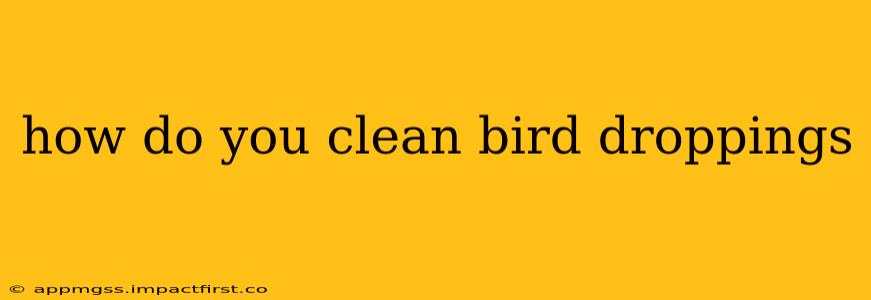Bird droppings, while a natural occurrence, can be a nuisance, especially when found on surfaces around your home or business. Cleaning them effectively requires understanding the best methods for different surfaces and situations. This guide provides a comprehensive approach to tackling this common cleaning challenge.
What's the Best Way to Clean Bird Droppings?
The "best" way depends entirely on the surface affected. Bird droppings are acidic and can etch or stain if left to dry, so prompt action is key. Always wear gloves to protect your hands. Here's a breakdown:
For Hard Surfaces (e.g., cars, windows, patios):
- Initial Removal: Scrape off as much dried droppings as possible with a stiff brush or spatula. Avoid spreading the droppings. Discard the debris carefully.
- Cleaning Solution: Mix a solution of warm water and mild dish soap. For tougher stains, you can add a small amount of white vinegar (this helps neutralize the uric acid).
- Application: Apply the solution to the affected area using a sponge or cloth. Gently scrub to lift the stain.
- Rinse: Rinse thoroughly with clean water to remove all traces of soap and vinegar. For car surfaces, use a car wash soap and ensure thorough rinsing to prevent water spots.
- Drying: Allow the surface to air dry or wipe it dry with a clean cloth.
For Fabrics (e.g., upholstery, clothing):
- Immediate Action: Blot (don't rub!) the affected area with a clean cloth or paper towel to absorb as much of the droppings as possible. Rubbing will spread the stain and make it harder to remove.
- Pre-Treatment: Carefully remove any solid matter before proceeding.
- Washing: Follow the care instructions on the fabric label. Most fabrics can be treated with a mixture of warm water and mild detergent. If the stain persists, consider a specialized enzyme cleaner designed for pet stains, as these are effective on organic matter like bird droppings.
- Drying: Allow the fabric to air dry completely.
For Delicate Surfaces (e.g., wood, painted surfaces):
- Gentle Cleaning: Use a soft cloth and a diluted solution of mild soap and water. Avoid harsh scrubbing which can damage the surface.
- Test First: Before applying any cleaning solution, test it on an inconspicuous area to ensure it doesn't damage the finish.
- Thorough Rinsing: Rinse the area thoroughly to prevent residue buildup.
How Do I Clean Bird Droppings From My Car?
Cleaning bird droppings off your car is similar to cleaning hard surfaces, but with an added focus on preventing damage to the car's paint. Using a dedicated car wash soap and a soft sponge or wash mitt is recommended. Remember to rinse thoroughly to avoid water spots. For stubborn stains, a dedicated car cleaning product might be necessary.
How Do You Get Rid of Bird Droppings Smell?
The smell of bird droppings is primarily due to the uric acid content. While cleaning will remove most of the visual mess, a lingering odor might remain. To neutralize the smell:
- Vinegar: A solution of vinegar and water can help neutralize the odors.
- Baking Soda: Baking soda can absorb odors. Sprinkle it on the affected area, let it sit for a few hours, then vacuum it up.
- Commercial Odor Eliminators: Several commercial products are designed specifically to eliminate pet and other organic odors. These can be particularly effective.
How Do I Prevent Bird Droppings?
Preventing bird droppings is often easier than cleaning them up. Here are a few preventative measures:
- Deterrents: Use bird spikes or netting to discourage birds from landing on specific areas.
- Clean Regularly: Regular cleaning discourages birds from returning to the same spot.
- Remove Food Sources: Eliminate food sources such as open garbage cans or spilled birdseed.
- Trim Trees and Bushes: Trimming overhanging branches can reduce access points for birds.
Remember, safety first! Always wear gloves and eye protection when cleaning bird droppings. If you are unsure about cleaning a specific surface, it’s always best to seek professional help. This comprehensive guide offers a variety of cleaning solutions tailored to diverse situations. Remember to always prioritize the safety of yourself and the surfaces you're cleaning.
